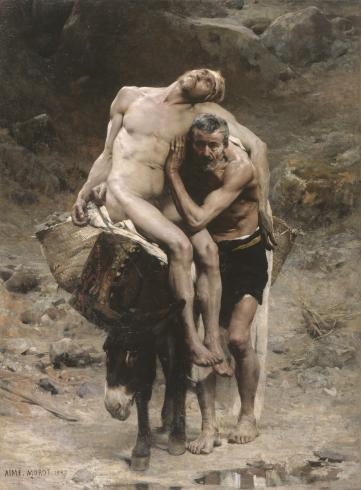Born into a modest, actively Republican family, Aimé Morot pursued an exemplary career after receiving an academic training in the studio of Alexandre Cabanel. Winner of the Prix de Rome in 1873, he used his stay at the Medici Villa as an opportunity to explore the Roman countryside on horseback.
His taste for travel and hunting subsequently took him to Africa and India.
On his return from his period of residency in Rome, the young Morot drew inspiration from the Gospel according to Luke to paint his Good Samaritan. The painting was exhibited in Paris at the Salon des Artistes français, where he was awarded the medal of honour by his peers.
Heavily influenced by Spanish art of the 17th century, Morot treated the parable of the Samaritan helping the wounded man with grave realism. His vigorous style found favour with contemporary critics who paid tribute to the virtuosity of this fine painting. Marie Bashkirtseff wrote enthusiastically in her diary: “This is the painting which has given me the most complete pleasure in my entire life. Nothing jars, everything is simple, true and good”.
Painted initially in a large format, the work was reduced on all four sides by the painter in order to refocus the composition on the two men depicted life-size. An enthusiast of animal subjects, Morot adds a moving dimension to the figure of the donkey labouring under its burden.
I. C.

City of Paris municipal collection's website
The collections portal can be used to search the collections of Paris’s 14 municipal museums (approximately 336,000 works, including 43,000 belonging to the Petit Palais).
It is also possible to download around 12,000 images of the museum’s works free of charge.
Access the Museums of the City of Paris collections portal
Extern databases
Discover a selection of databases online presenting works from the Petit Palais or documents concerning the history of the museum.

